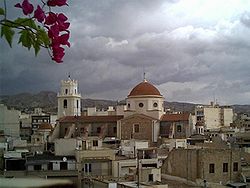Crevillent: Difference between revisions
m r2.7.1) (Robot: Adding kk:Кревильенте |
No edit summary |
||
| Line 69: | Line 69: | ||
The most important tourist places of the city are is a museum with works of [[Mariano Benlliure]], a Valencian [[sculpture|sculptor]]. Also remarkable is its ''[[Moros i Cristians]]'' festival. |
The most important tourist places of the city are is a museum with works of [[Mariano Benlliure]], a Valencian [[sculpture|sculptor]]. Also remarkable is its ''[[Moros i Cristians]]'' festival. |
||
Many of the agricultural areas, particularly El Realengo, contain ruins of prisons, ovens and torture houses used during [[Fransisco Franco]]'s reign and the [[Spanish Civil War]] in the early 1900's |
|||
==External links== |
==External links== |
||
Revision as of 17:27, 26 July 2012
Crevillent | |
|---|---|
 Church of Mare de Déu de Betlem | |
| Country | |
| Autonomous community | |
| Province | Alicante |
| Comarca | Baix Vinalopó |
| Judicial district | Elx |
| Government | |
| • Mayor | César Augusto Asencio Adsuar (PP) |
| Area | |
• Total | 104.50 km2 (40.35 sq mi) |
| Elevation | 130 m (430 ft) |
| Population (2009) | |
• Total | 28,609 |
| • Density | 270/km2 (710/sq mi) |
| Time zone | UTC+1 (CET) |
| • Summer (DST) | UTC+2 (CEST) |
| Postal code | 03330 |
| Official language(s) | Valencian |
| Website | Official website |
Crevillent (Catalan pronunciation: [kɾeviˈʎent], Spanish: [Crevillente] Error: {{Lang}}: text has italic markup (help) [kɾeβiˈʎente]) is a town and municipality located in the Alicante province, part of the Valencian Community, Spain. It is situated in the comarca of Baix Vinalopó, and lies at the foot of the hill range known locally as Serra de Crevillent. As of 2009[update], it has a total population of 28,609 inhabitants.
The terrain is dry, and its main vegetation is composed by carob trees, almond trees, olive trees and esparto. Crevillent is a major carpets production center.
The town was probably settled by Romans. In 1263, during the period known as Reconquista, James I of Aragon captured the city from the Moors and became a part of the Kingdom of Valencia.
The most important tourist places of the city are is a museum with works of Mariano Benlliure, a Valencian sculptor. Also remarkable is its Moros i Cristians festival.
Many of the agricultural areas, particularly El Realengo, contain ruins of prisons, ovens and torture houses used during Fransisco Franco's reign and the Spanish Civil War in the early 1900's
External links

